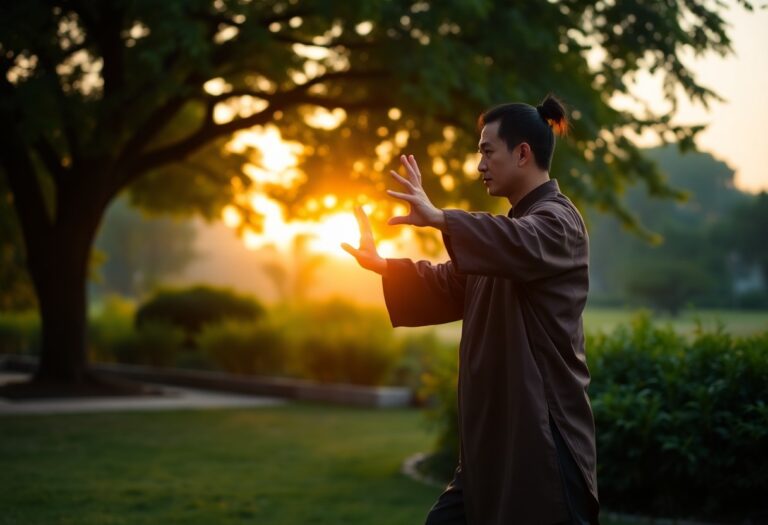Tai Chi for Better Posture and Alignment
Many individuals struggle with maintaining proper posture and alignment in their daily lives, often leading to discomfort and strain. Engaging in Tai Chi can provide you with an effective means to improve your posture through its gentle movements and mindful practices.
This ancient martial art not only enhances flexibility and balance, but also fosters an awareness of your body’s alignment, helping you to cultivate a stronger, more stable foundation. In this guide, you will discover how to incorporate Tai Chi into your routine for better overall body alignment and posture.
Understanding Posture and Alignment
The foundation of optimal body mechanics lies in your posture and alignment. Good posture involves maintaining the natural curves of your spine while standing, sitting, or moving. Alignment refers to how your body parts align with one another and with gravity. Proper posture and alignment not only enhance physical appearance but also improve overall health, reducing strain on muscles and joints.
The Importance of Proper Posture
Any effort you make to maintain proper posture can lead to significant benefits. Good posture helps in efficiently distributing weight across the body, which reduces fatigue and discomfort. By practising proper alignment, you can enhance your performance in daily activities and minimise the risk of injuries.
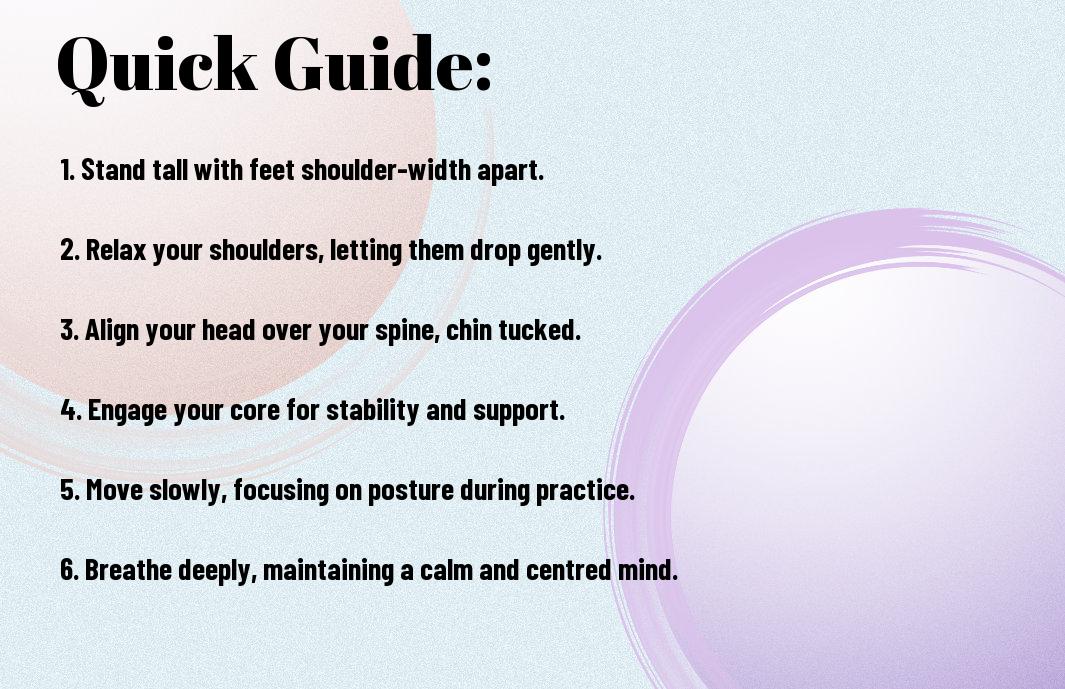
Effects of Poor Posture on Health
Proper posture is not merely an aesthetic concern; it directly impacts your health. Poor posture can lead to problems such as chronic pain, fatigue, and decreased functionality. Over time, imbalances can arise, further exacerbating stress on your musculoskeletal system.
Plus, persistent poor posture can lead to a range of health complications, including headaches, neck and back pain, and digestive issues. When your spine is out of alignment, it can put pressure on your nerves, leading to discomfort and reduced mobility. Maintaining good posture is vital for overall well-being and can help you avoid these common issues.
Common Factors Contributing to Misalignment
The factors that lead to misalignment are often intertwined with your daily habits and lifestyle choices. Common contributors include:
- Prolonged sitting and sedentary behaviour
- Poor ergonomic setups at work
- Lack of physical activity
- Inappropriate footwear
- Muscle imbalances or weakness
Any one of these factors can significantly impact your alignment over time.
Another consideration when it comes to misalignment is your daily routine. Your everyday activities might be exacerbating poor posture and misalignment. Factors such as:
- Frequent use of electronic devices
- Catering to physical demands without proper support
- Stress and tension affecting body positioning
- Neglecting core strengthening exercises
Any lifestyle choice can play a role in how you stand, sit, and move throughout the day.
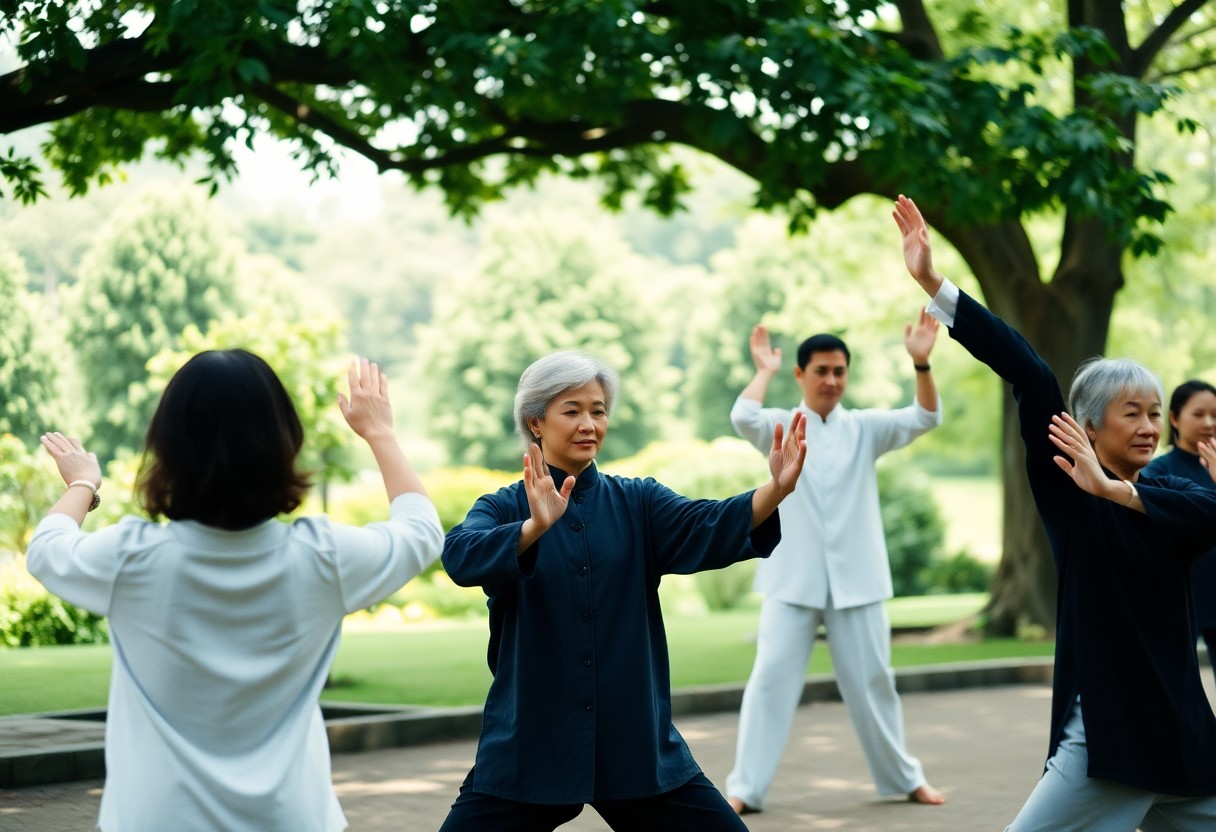
The Fundamentals of Tai Chi for Posture Improvement
Clearly, mastering the fundamentals of Tai Chi can significantly enhance your posture and alignment. This ancient practice focuses on fluid movements and mindful awareness, inviting you to develop a deeper connection with your body. By integrating these fundamentals into your daily routine, you can cultivate better alignment and stability, ultimately improving your overall posture.
Principles of Tai Chi Relevant to Posture
For effective posture improvement, Tai Chi emphasises principles such as relaxation, balance, and mindfulness. These concepts encourage you to centre yourself and engage your core, promoting a more aligned skeletal structure. As you adopt these principles, you will notice improvements in your standing and sitting postures, as well as a reduction in muscle tension.
How Tai Chi Promotes Alignment
With regular practice, Tai Chi encourages proper alignment through its slow, deliberate movements. This process allows you to become more attuned to your body’s positioning, strengthening the muscles necessary to support an erect and balanced posture. As you move, you identify areas of misalignment and consciously correct them via gentle adjustments.
Alignment in Tai Chi isn’t just about physical posture; it encompasses mental awareness and energy flow. By engaging in Tai Chi, you learn to release tension, allowing your body to find its natural alignment. The gentle, flowing movements facilitate a recalibration of your body’s centre, reducing strain on your back and neck. Over time, this process leads to improved muscular support and a more poised stance in everyday activities.
The Role of Breath in Tai Chi Practice
Fundamentals of Tai Chi heavily rely on breath, serving as a vital component in aligning your body and mind. As you practice, your breath guides the flow of movements, enabling you to maintain focus and relaxation. This connection between breath and movement supports posture improvement by nurturing a sense of calm and stability.
This deep connection between breath and physical alignment enhances your awareness of how your body moves through space. By coordinating your breathing with fluid movements, you reduce muscle tension and unlock greater flexibility, allowing your body to settle into healthier postures. Furthermore, conscious breathing promotes mindfulness, assisting in the overall alignment of your physical and mental state during Tai Chi practice.
Types of Tai Chi Styles and Their Benefits
Your experience with Tai Chi can vary significantly depending on the style you choose. Each style offers unique benefits that can enhance your posture and alignment. Below is a table outlining some of the main Tai Chi styles and their advantages:
| Style | Benefits |
|---|---|
| Yang Style | Promotes relaxation and balance. |
| Chen Style | Increases strength and flexibility. |
| Wu Style | Focuses on a graceful, smaller frame. |
| Sun Style | Incorporates agile steps and lively movements. |
| Mixed Styles | Combines various techniques for versatility. |
Recognising which style aligns with your goals can be instrumental in your Tai Chi journey.
Yang Style Tai Chi
On engaging with Yang Style Tai Chi, you will find a gentle yet effective practice that emphasises fluid movements and continuous flow. This style is widely popular for its accessibility, making it an excellent choice for beginners seeking to improve their posture.
Chen Style Tai Chi
Their distinct characteristic lies in its dynamic nature, mixing slow movements with bursts of speed and power, making it ideal for those wanting a more vigorous workout. This style is excellent for building physical strength and enhancing flexibility.
Another significant aspect of Chen Style Tai Chi is its rich history and deep-rooted traditions, which contribute to its complexity and depth. By practising this style, you will not only develop physical acumen but also connect with the cultural heritage of Tai Chi, enriching your overall experience.
Wu Style Tai Chi
Little known but highly respected, Wu Style Tai Chi is characterised by its compact movements and gentle postures. This style enhances balance and promotes a deep sense of internal peace.
Style differentiation in Wu Tai Chi is particularly evident in its emphasis on a smaller frame and optimised body alignment. By concentrating on these principles, you can achieve an improved sense of stability and posture, making it an excellent option for enhancing your overall alignment.
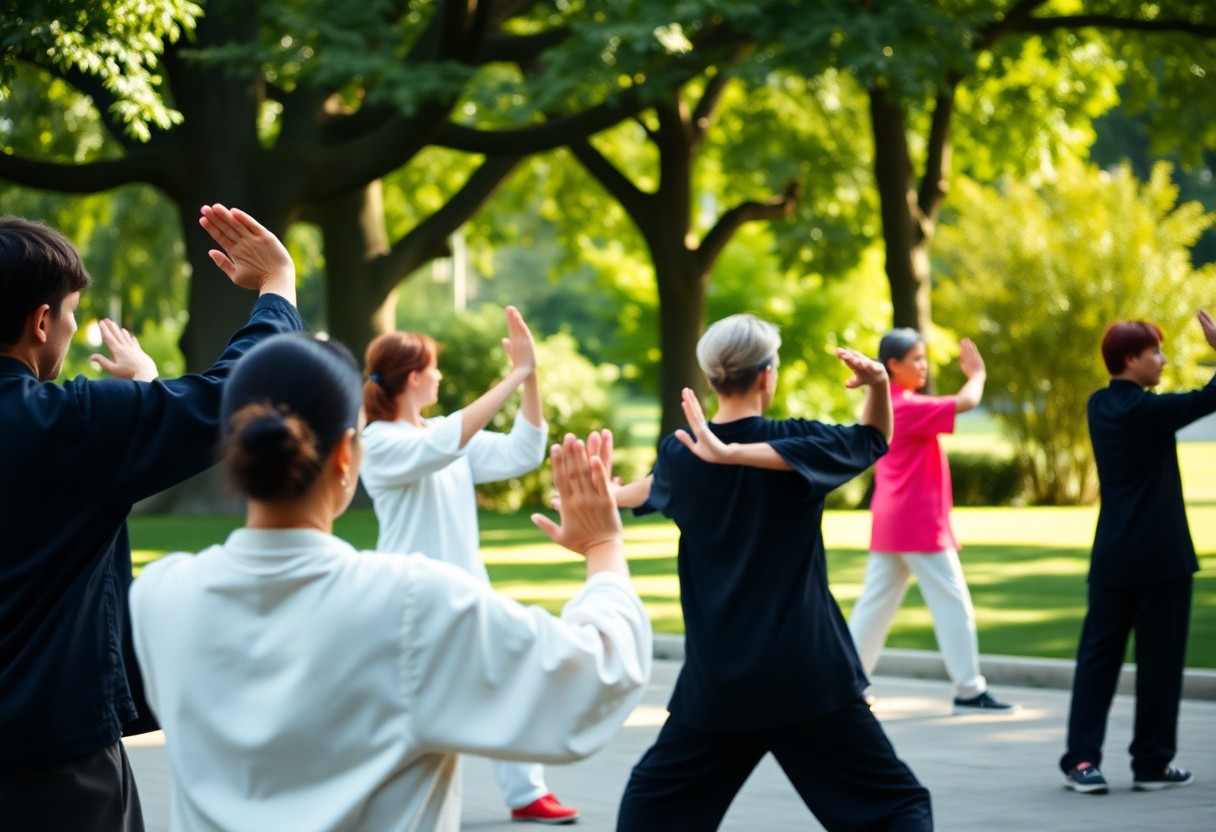
Step-by-Step Guide to Basic Tai Chi Movements
Now, let’s probe into the foundational movements of Tai Chi that will enhance your posture and alignment. Below is a simple breakdown of these basic movements.
| Movement | Description |
| Commencing Form | Sets the stage for relaxation and focus. |
| Ball of Foot | Helps you find balance while shifting weight. |
| Wave Hands Like Clouds | Enhances fluidity and grace in movement. |
| Closing Form | Brings all energy back to your centre. |
Warm-Up Exercises
One effective way to prepare your body for Tai Chi is through warm-up exercises. These light activities increase blood flow and enhance flexibility, ensuring that your muscles are ready for movement. Simple stretches for the arms, legs, and back can help you transition smoothly into Tai Chi practice.
Essential Tai Chi Forms for Alignment
An integral part of improving your posture is mastering necessary Tai Chi forms. Each form focuses on specific principles of alignment, ensuring that your body maintains its natural structure during movement. Learning these forms can dramatically impact your overall stability and grace.
Another key aspect of Tai Chi forms is their emphasis on slow, deliberate movements that promote body awareness. As you practice, you begin to realise how each position supports your alignment, allowing you to release tension and improve balance. This gradual process encourages mindfulness, facilitating a deeper connection between your body and mind, which is necessary for maintaining good posture.
Cool Down and Reflection Techniques
Cool down properly after your Tai Chi session to help your body relax and recover. Gentle stretches combined with deep breathing can aid in dissipating any residual tension, allowing you to fully integrate the benefits of your practice.
Reflection is an important part of the cool-down process. Take a few moments to contemplate your practice, noticing how you feel in your body and mind. This self-reflection not only enhances your awareness but also reinforces the lessons learned during your Tai Chi session, fostering continuous improvement in your posture and alignment.
Tips for Incorporating Tai Chi into Daily Life
Many people find it beneficial to weave Tai Chi into their daily routines. Here are some tips to help you get started:
- Set a regular time for your practice
- Incorporate short sessions throughout the day
- Practice with a friend for motivation
- Focus on your breathing during routine activities
- Join a community group for support
The journey towards better posture through Tai Chi becomes more enjoyable with daily integration.
Finding Time for Practice
Little increments of time can yield significant benefits when it comes to Tai Chi. You might find it easier to practice in the morning, during your lunch break, or even before bedtime. The key is to identify periods in your schedule where you can dedicate just a few moments to movement, ensuring consistency over time.
Creating a Comfortable Environment
Practice in a space where you feel relaxed and can move freely. Choose a quiet area, ideally with natural light and good ventilation, to enhance your concentration and enjoyment. Having minimal distractions will help you connect more deeply with your movements and intentions.
Creating a comfortable environment for your Tai Chi practice can significantly enhance your experience. Consider using a yoga mat for added comfort and stability, and adjust the room temperature to something that feels good for your body. You might also want to eliminate clutter and create a calming atmosphere with soft lighting or soothing music, allowing you to focus entirely on your practice.
Utilizing Online Resources and Local Classes
Little resources are available online, including videos, tutorials, and live classes, making it easier than ever to learn Tai Chi at your convenience. Consider exploring different styles and teachers to find what resonates with you.
Life is full of choices, and your Tai Chi journey can be enriched by utilising online resources and local classes. Online platforms often provide a variety of instructional styles and levels, allowing you to explore at your own pace. Local classes offer the added benefit of community, where you can connect with fellow practitioners, receive personalised feedback, and participate in group energy, which can motivate and inspire you to progress.
Modifying Tai Chi for Individual Needs
Unlike a one-size-fits-all approach, modifying Tai Chi allows you to personalise the practice to fit your unique body and abilities. This ensures greater enjoyment and more effective results, fostering a deeper connection with each movement. By paying attention to your specific requirements, you can achieve better posture and alignment while practising safely.
Assessing Personal Limitations
An vital first step in modifying Tai Chi is assessing your personal limitations. Take some time to evaluate your current physical abilities, any pre-existing health conditions, and areas where you experience discomfort or difficulty. This will help you understand how to adapt movements to accommodate your needs and ensure you engage in a beneficial practice.
Tailoring Movements for Different Body Types
With various body types and flexibility levels, tailoring Tai Chi movements is vital for optimal practice. Here are some key considerations:
| Body Type | Movement Adjustment |
|---|---|
| Tall | Wider stance for stability |
| Short | Smaller, more compact movements |
| Stocky | Focus on balance and grounding |
| Lean | Emphasise flow and grace |
| Muscular | Incorporate strength into transitions |
Your body type influences how you perform movements in Tai Chi, so adjusting them accordingly enhances your experience. Consider these aspects:
- Posture adaption based on limb length
- Foot positioning to support weight distribution
- Speed of movements that align with your natural rhythm
- Breath control techniques suited to your level of relaxation
- Comfort level during each posture.
The right modifications allow you to engage fully with the practice and promote better alignment.
Using Props and Supports
While it is common to imagine Tai Chi as a free-flowing art form, utilising props and supports can enhance your comfort and effectiveness. Items such as chairs, wall supports, or resistance bands can assist you in achieving proper posture and alignment without strain.
Personalising your practice with props can lead to a more enjoyable experience. Engaging with the right tools tailored to your needs enhances stability and balance:
- Chairs for seated exercises
- Ballet barres for stability
- Yoga blocks for alignment
- Resistance bands for strength
- Soft mats for comfort.
The use of props ensures you can practise Tai Chi safely, focusing on mindfulness without the risk of over-exertion or injury.
The Mind-Body Connection in Tai Chi Practice
For many practitioners, Tai Chi offers a profound way to enhance the mind-body connection, leading to improved posture and alignment. By engaging in this gentle form of exercise, you allow your mind to harmonise with your body, fostering a deeper awareness of your physical presence and movements. This synergy not only promotes relaxation but also cultivates greater balance, empowering you to carry yourself more confidently throughout the day.
Focus and Awareness in Movement
Any Tai Chi session invites you to immerse yourself fully in the experience, sharpening your focus and awareness. As you practise each movement, you develop an acute sense of your body’s alignment and posture, allowing for a more intentional way of moving. This heightened awareness helps you identify areas of tension or imbalance, leading to increased comfort and fluidity in your daily activities.
Emotional Balance Through Tai Chi
Clearly, Tai Chi not only nurtures physical well-being but also plays a vital role in achieving emotional balance. The slow, deliberate movements encourage a meditative state, helping you release stress and cultivate a sense of calm within. As you connect with your breath, you may find that your emotional responses become more regulated, leading to enhanced stability in your everyday life.
Plus, this practice can serve as a powerful emotional outlet, enabling you to process feelings and cultivate resilience. The rhythmic movements and mindful breathing establish a safe space to explore your inner thoughts and emotions, promoting a sense of ease and acceptance. As you continue to develop this emotional balance through Tai Chi, you may notice a positive shift in how you perceive yourself and interact with the world around you.
Cultivating a Positive Mindset for Better Posture
Positive thinking is a significant element in your Tai Chi journey, influencing not only your mindset but also your physical posture. By adopting an optimistic outlook, you can empower yourself to move with intention and grace. This uplifting attitude fosters greater confidence, which ultimately reflects on your body language and overall alignment.
Movement is not merely physical; it encompasses your mental and emotional state as well. When you cultivate a positive mindset, you begin to internalise the essence of Tai Chi, allowing it to resonate in your posture and alignment. Embracing positivity helps alleviate the tension often held in your body, leading to greater ease and fluidity in your movements. Ultimately, this harmonious blend of body and mind contributes to a powerful transformation in how you carry yourself in both practice and everyday life.
Common Misconceptions about Tai Chi and Posture
To gain a true understanding of Tai Chi’s role in improving posture, it’s imperative to sift through common misconceptions. Many people believe that Tai Chi is merely a slow form of exercise, but in reality, it encompasses principles that promote alignment and strengthen your body. Often, the notion that Tai Chi is only for the elderly or for those with health issues can undermine its broader applicability as a tool for anyone seeking better posture and overall balance.
Addressing Myths and Misunderstandings
Some individuals may think Tai Chi is too gentle to yield significant benefits for posture. This misconception stems from its slow movements, leading to the belief that it lacks intensity. However, Tai Chi’s focus on mindful movement and breath control actually engages your core muscles, enhancing strength and stability, which are vital for maintaining proper alignment.
Clarifying Tai Chi vs. Other Exercise Forms
Exercise forms that prioritise speed and repetition often overshadow Tai Chi’s unique approach to posture and alignment. Tai Chi is not about quick transitions but rather emphasises fluidity and control, allowing your body to develop awareness of posture through each deliberate movement.
Forms of exercise like running or weightlifting provide physical benefits but can compromise posture due to the emphasis on intensity and speed. Tai Chi, in contrast, nurtures kinesthetic awareness and promotes gradual improvements in alignment. You engage your entire body, cultivating a deeper understanding of how posture impacts overall well-being, unlike the more compartmentalised focus of traditional workout regimes.
The Science Behind Tai Chi’s Effectiveness
An increasing body of research supports the effectiveness of Tai Chi in improving posture. Studies reveal that its meditative nature, combined with physical movement, enhances proprioception—the awareness of your body in space—allowing you to make subtle adjustments to your posture more easily.
This heightened awareness not only aids in posture correction but also contributes to overall physical stability and confidence. Investigations have shown that consistent practice can lead to measurable changes in alignment, positively impacting other aspects of your life, including balance and flexibility. Embracing Tai Chi may not only reshape your posture but also redefine your relationship with movement.
Evaluating the Pros and Cons of Tai Chi for Posture
All practitioners should consider the benefits and drawbacks of Tai Chi as a means to improve posture. The practice offers numerous advantages, but there are also challenges that you may face. The table below outlines the key pros and cons to help you make an informed decision.
| Pros | Cons |
| Enhances balance and stability | Requires consistent practice |
| Improves muscle strength | Learning can take time |
| Promotes relaxation and stress relief | May be difficult for some due to physical limitations |
| Increases body awareness | Availability of qualified instructors may vary |
| Supports mental focus | Requires a commitment to long-term practice |
Benefits of Regular Practice
On engaging regularly with Tai Chi, you can experience significant improvements in your posture and overall alignment. By integrating the gentle movements and breathing techniques into your daily routine, you increase flexibility, enhance muscular strength, and cultivate better body awareness. Consequently, you enable your body to maintain a more balanced and aligned stance, reducing the risk of injury over time.
Potential Challenges and Limitations
Clearly, while Tai Chi offers many benefits, you may also encounter challenges. Some individuals may find it difficult to master the movements or develop patience as progress can be slow. Additionally, physical limitations or health issues might hinder your ability to participate fully in the practice, which could affect your posture improvement journey.
It is imperative to approach Tai Chi with realistic expectations. Not every class or instructor will suit your personal needs, and the time it takes to see results can vary significantly. You may need to be patient and persistent in your practice, especially if you’re starting with previous injuries or mobility concerns that could influence your progress.
Long-Term Commitments and Outcomes
Practice of Tai Chi offers long-term benefits for posture, but it does require dedication. As you commit to consistent training, improvements in alignment and body awareness can become more pronounced, leading to lasting changes in your posture and overall well-being. The key is to incorporate Tai Chi into your lifestyle, ensuring that these benefits are sustainable over time.
Plus, by making Tai Chi a regular part of your routine, you can expect not only improvements in posture but also enhanced mental clarity and emotional stability. Establishing this practice as a lifelong commitment can significantly contribute to your physical health and quality of life, fostering a deeper connection between your body and mind as you age.
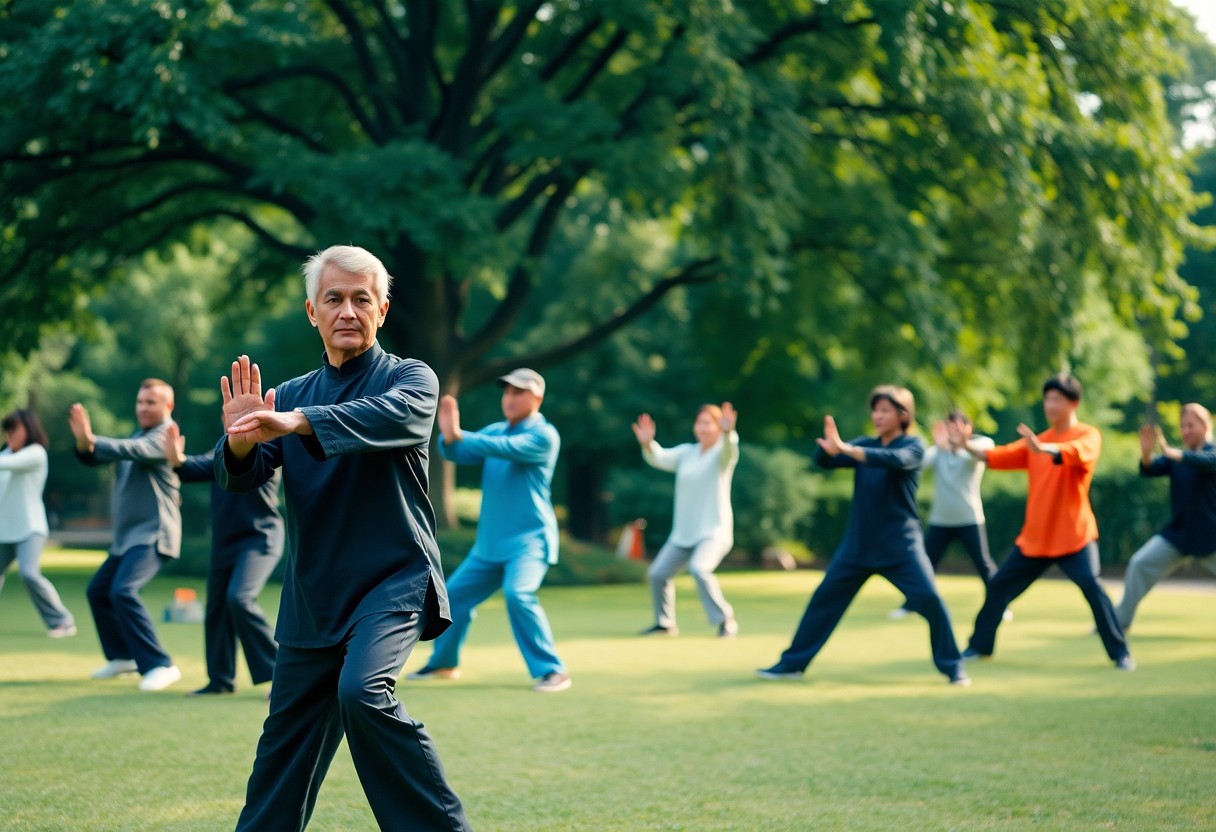
The Role of Professional Guidance in Tai Chi
Despite the self-teaching resources available for Tai Chi, professional guidance can significantly enhance your practice. An experienced instructor can provide personalised feedback, helping you correct your movements and better understand the principles behind the exercises. Their expertise ensures you develop the right techniques from the very beginning, which is necessary for improving posture and alignment effectively.
When to Seek a Tai Chi Instructor
Some signs indicate it may be time to seek a Tai Chi instructor, such as feeling unsure about your technique or finding it difficult to avoid injury during practice. Engaging with an instructor can bolster your understanding of the art, deepen your practice, and provide clarity on your personal goals in Tai Chi.
Benefits of Group vs. Solo Practice
Group practice can foster a sense of community and shared learning, enhancing your motivation and commitment to Tai Chi. The dynamic of a class often encourages you to improve faster and provides the opportunity for social interaction, which is beneficial for mental well-being.
It is during group practice that you can gain invaluable insights from others, as well as from the instructor’s guidance. The collective energy and corrections offered in a shared environment can inspire you to push your boundaries and explore new techniques. Conversely, while solo practice allows for personal reflection and flexibility in timing, a group setting often accelerates your progress and keeps you accountable to your goals.
Understanding Credentials and Expertise
Benefits of selecting a qualified Tai Chi instructor include their ability to provide tailored instruction based on their extensive training and experience. Verify their credentials and teaching style to ensure they align with your personal goals and needs.
The expertise of your instructor is vital for developing a solid foundation in Tai Chi. Look for teachers with recognised qualifications and experience in the art, as well as those who demonstrate a commitment to ongoing education. A knowledgeable instructor can not only teach you the movements but also impart the philosophy and health benefits that come with advanced practice, ensuring a comprehensive learning experience.
Progress Tracking and Goal Setting
Keep a journal to document your journey in Tai Chi. Setting specific targets can help you stay motivated and observe improvements in your posture and alignment. Regularly reflect on your experiences to adjust your goals accordingly and maximise your benefits from practice.
Setting Realistic Posture Goals
Goal setting plays a pivotal role in your Tai Chi practice. Focus on achievable objectives that challenge you without overwhelming you. Breaking down larger goals into smaller, manageable steps will help you build confidence and allow for noticeable progress over time.
Monitoring Progress Over Time
Assuming you commit to tracking your posture regularly, you will likely become more aware of subtle changes. Consider taking photographs or using a posture assessment tool to observe your development. This will help you identify areas that require further attention and encourage you to maintain consistency in your practice.
Monitoring your progress can be very motivating. By reviewing your posture on a weekly or monthly basis, you can witness the evolution of your alignment and make necessary adjustments to your technique. Documenting these changes not only boosts your confidence but also reinforces your commitment to the practice.
Celebrating Milestones in Practice
Assuming you reach specific milestones, take the time to acknowledge your achievements. Celebrating your progress reinforces positive habits and encourages you to continue striving for improvement in your posture and alignment. Consider treating yourself or sharing your success with fellow Tai Chi practitioners.
To truly appreciate your dedication, recognising and celebrating milestones is necessary. Whether it is mastering a particular Tai Chi form or noticing a significant improvement in your posture, reflecting on your achievements not only keeps you motivated but also reinforces your commitment to your Tai Chi journey.
Integrating Tai Chi with Other Posture Improvement Techniques
Once again, you will find that combining Tai Chi with other posture improvement techniques can significantly enhance your results. By blending the mindful movements of Tai Chi with additional practices, you can refine your alignment and develop a more robust sense of body awareness. This holistic approach allows you to address multiple facets of posture correction while ensuring a balanced and comprehensive improvement in your physical well-being.
Combining Tai Chi with Stretching
With the gentle flow of Tai Chi, you can easily incorporate stretching routines to further improve your flexibility and posture. As you move through Tai Chi sequences, integrating targeted stretches can help release tension in tight muscles, allowing for better alignment and stability. This combination fosters a deeper understanding of how your body moves, ultimately enhancing both your Tai Chi practice and your overall posture.
Merging Tai Chi with Strength Training
On integrating Tai Chi with strength training, you will experience a unique synergy that helps in building a strong foundation for posture. By combining the fluid movements of Tai Chi with resistance exercises, you not only develop muscle strength but also improve balance and coordination. This fusion enables you to engage your core, stabilise your spine, and ultimately promote a more aligned body posture.
Improvement in your posture can be substantial when you merge Tai Chi with strength training. As you strengthen key muscle groups, you enhance your ability to maintain proper alignment throughout your daily activities. The mindful nature of Tai Chi complements strength training, allowing you to focus on controlled movements and body awareness. This integration helps to ensure that you are not only building strength but also using it effectively to support a healthy posture.
Incorporating Mindfulness and Meditation
Strengthening your posture can also be achieved by incorporating mindfulness and meditation alongside your Tai Chi practice. By fostering a deeper connection with your body and breath, you can cultivate awareness of postural habits and the subtle adjustments needed to improve alignment. Mindfulness encourages you to engage with the present moment, allowing you to identify and release tension that may be contributing to poor posture.
Other practices of mindfulness and meditation complement Tai Chi by equipping you with techniques to centre yourself and reduce stress. Regularly engaging in these practices helps create a mental environment conducive to physical change, enhancing your overall focus on posture. By marrying these mindful practices with the fluidity of Tai Chi, you create a comprehensive approach that nurtures both your mind and body, ultimately leading to improved alignment and well-being.
Addressing Common Questions about Tai Chi
After exploring the benefits of Tai Chi, you may have some questions about its practice and suitability. Understanding these common queries can help you make an informed decision about integrating Tai Chi into your routine for better posture and alignment.
How Long Before I See Improvements?
You might be wondering how long it will take before you notice improvements in your posture and alignment through Tai Chi practice. Typically, many practitioners report experiencing positive changes within a few weeks of consistent practice. However, the extent and speed of these improvements can vary based on individual commitment and frequency of sessions.
Is Tai Chi Suitable for Everyone?
Before launching on your Tai Chi journey, it’s important to consider whether this practice is right for you. Tai Chi is designed to be accessible for individuals of varying ages and fitness levels. Whether you are a seasoned athlete or a beginner, you can tailor your Tai Chi practice to suit your personal needs and abilities.
Addressing concerns about the suitability of Tai Chi, it is a low-impact exercise that allows for modifications, making it an excellent choice for those recovering from injury or dealing with chronic conditions. As always, consulting with a healthcare professional is advisable if you have specific health concerns before starting any new exercise regimen.
What Should I Wear for Practice?
Assuming you are new to Tai Chi, you might be curious about what attire is appropriate for your practice sessions. Comfortable clothing that allows for a full range of movement is recommended. Opt for breathable fabrics, as this can enhance your experience and help you focus on your movements.
This choice in clothing is significant as it ensures that you can perform Tai Chi’s fluid motions without restriction. Loose-fitting trousers and a simple top are ideal, allowing you to stay cool while maintaining flexibility in your movements. Proper footwear, such as flat, supportive shoes, can also enhance stability during practice.
Summing up
Upon reflecting on the benefits of Tai Chi for better posture and alignment, you may find that this ancient practice supports your body’s natural mechanics. By incorporating gentle movements and focused breathing, you can enhance your awareness of posture, leading to improved balance and alignment. Regular practice of Tai Chi not only promotes physical well-being but also fosters a mindful connection between your body and mind, empowering you to maintain good posture in your daily life.


